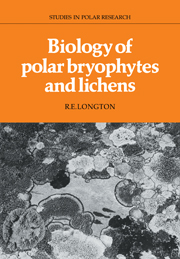Book contents
- Frontmatter
- Contents
- Preface
- 1 The polar regions
- 2 The cryptogamic vegetation
- 3 Pattern, process and environment
- 4 Radiation and microclimate
- 5 Physiological processes and response to stress
- 6 Vegetative growth
- 7 Cryptogams in polar ecosystems
- 8 Reproductive biology and evolution
- References
- Index of generic and specific names
- Subject index
4 - Radiation and microclimate
Published online by Cambridge University Press: 24 April 2010
- Frontmatter
- Contents
- Preface
- 1 The polar regions
- 2 The cryptogamic vegetation
- 3 Pattern, process and environment
- 4 Radiation and microclimate
- 5 Physiological processes and response to stress
- 6 Vegetative growth
- 7 Cryptogams in polar ecosystems
- 8 Reproductive biology and evolution
- References
- Index of generic and specific names
- Subject index
Summary
Solar radiation
Variation with latitude
Solar radiation exerts a pervasive influence on plant–environment relationships, supplying the energy available for photosynthesis and controlling temperature and water regimes in the microclimate of lowgrowing cryptogamic vegetation. Microclimatic conditions differ dramatically from those indicated by standard meteorological recording, and must be analysed in many types of ecophysiological investigation. Walton (1984) has recently provided a critical review of microclimatic studies in the Antarctic.
All energy received at the earth's surface, apart from a small amount of geothermal heat, originates as solar radiation. The solar constant, i.e. the irradiance of a plane perpendicular to the sun's rays at the outer edge of the atmosphere and at the earth's mean distance from the sun, is approximately 8.4 J cm−2 min−1 (= 2.0 cal cm−2 min−1 or 1402 W m−2). Radiation receipt at the earth's surface varies widely in response to changes with latitude in the angle of solar elevation, in daylength regimes, and in attenuation of radiation during passage through the atmosphere.
The angle of solar elevation (Fig. 4.1), and therefore maximum irradiance, fall progressively from the tropics towards the poles. Daylength varies with latitude because the earth's axis of rotation is inclined in relation to its plane of revolution around the sun (Fig. 4.1), resulting in pronounced seasonality and relatively low diurnal fluctuation in solar irradiance in polar regions. At the northern summer solstice, regions north of the Arctic circle lie in the path of direct solar radiation 24 hours per day whereas south of the Antarctic circle there is no direct insolation, the converse being true at the northern winter solstice.
- Type
- Chapter
- Information
- Biology of Polar Bryophytes and Lichens , pp. 106 - 140Publisher: Cambridge University PressPrint publication year: 1988
- 1
- Cited by



